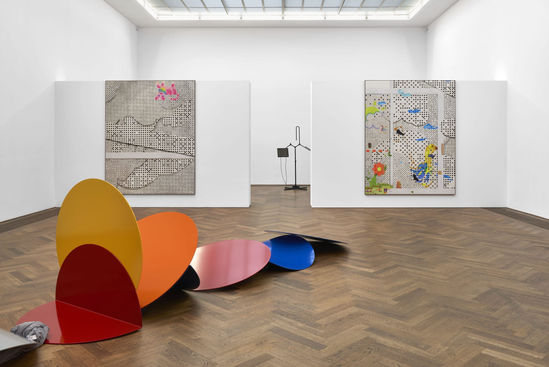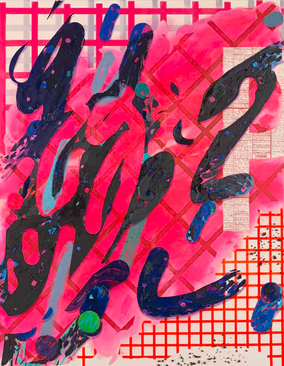For my further artistic practice I would like research the accelerating effect the implementation of digital technology and algorithms has on an individual.
For my further artistic practice I would like research the accelerating effect the implementation of digital technology and algorithms has on an individual.
Artworks and Processes
Artworks and Processes
Artworks and Processes
Artworks and Processes
Here is a heading
Ich bin ein Textabschnit. Klicke hier, um deinen eigenen Text hinzuzufügen und mich zu bearbeiten. Ich bin ein Textabschnitt. Klicke hier, um deinen eigenen Text hinzuzufügen und mich zu bearbeiten.Ich bin ein Textabschnitt. Klicke hier, um deinen eigenen Text hinzuzufügen und mich zu bearbeiten.Ich bin ein Textabschnitt. Ich bin ein Textabschnitt. Klicke hier, um deinen eigenen Text hinzuzufügen und mich zu bearbeiten. Ich bin ein Textabschnitt. Klicke hier, um deinen eigenen Text hinzuzufügen und mich zu bearbeiten.Ich bin ein Textabschnitt. Klicke hier, um deinen eigenen Text hinzuzufügen und mich zu bearbeiten.Ich bin ein Textabschnitt.
Here is a heading
Ich bin ein Textabschnit. Klicke hier, um deinen eigenen Text hinzuzufügen und mich zu bearbeiten. Ich bin ein Textabschnitt. Klicke hier, um deinen eigenen Text hinzuzufügen und mich zu bearbeiten.Ich bin ein Textabschnitt. Klicke hier, um deinen eigenen Text hinzuzufügen und mich zu bearbeiten.Ich bin ein Textabschnitt. Ich bin ein Textabschnitt. Klicke hier, um deinen eigenen Text hinzuzufügen und mich zu bearbeiten. Ich bin ein Textabschnitt. Klicke hier, um deinen eigenen Text hinzuzufügen und mich zu bearbeiten.Ich bin ein Textabschnitt. Klicke hier, um deinen eigenen Text hinzuzufügen und mich zu bearbeiten.Ich bin ein Textabschnitt.
Laura Owens

© Laura Owens, Untitled 2012
“I really want paintings to be problems … The painting is coming out at you and asking you to put these things together.” – Laura Owens
large-scale paintings
“disparate” paintings
drop shadows
complex compositions
mix of digital and analogue processes
illusion and materiality
planes of information
Artists website → https://www.owenslaura.com/
“Over the past two and a half decades, Laura Owens has become one of the most influential painters of her generation.” – William Griswold, director of the Cleveland Museum of Art (CMA, 2021)
Laura Owens (American painter, gallery owner and educator) lives and works in Los Angeles, California. She is known for large-scale paintings that combine a variety of art historical references and painterly techniques. Her desire to create “disparate” paintings stems from her studies with Michael Asher at California Institute of the Arts in Valencia, California, in 1994. There she experienced an approach to art in which each element of a work had to be justified which she rejected. She developed the idea to make paintings where incongruous elements would meet on the same panel. (Tate 1; Tate 2)
Installation view, Kunsthalle Basel,
(left) Untitled [SMS +41 79 807 86 92], 2021
(right) Untitled [SMS +41 79 807 86 29], 2021
Photo: Philipp Hänger
INFORMATION (Today)
Kunsthalle Basel, 2021
“Encrypted networks, digital currencies, artificial intelligence, data harvesting, algorithmic biases, sentient machines—all are products of twenty-first-century data-based capitalism. As a result, the proliferation of information, and data’s nebulous modes of circulating and being processed, fundamentally shape our existence now.
INFORMATION (Today) is a group show featuring contemporary artists seeking to unravel this phenomenon. Encrypted networks, digital currencies, artificial intelligence, data harvesting, algorithmic biases, sentient machines: these are just some of its effects. The proliferation of information, and data’s nebulous modes of circulating now fundamentally shape our existence.”
(Kunsthalle Basel, 2021)
Laura Owens’s newly made painting is directly asking the viewer “Do you have a question?” followed by a Swiss telephone number. “Go ahead, send a question via text message!” She takes up the frustrating experience of speaking to “smart” devices and robo-call systems and sends out Wikipedia-style information on the city of Basel’s history or a description of another artwork in the exhibition in a real-time communicative feedback loop with an inanimate entity. (Kunsthalle Basel, 2021)
When looking at her paintings the viewer has to vary his viewing distance to grasp the entire composition of her complex surfaces. The differences between the thick peaks of paint and the flatness of the grids and lattices is further complicated by Owens’s use of computer painting programs. The addition of ‘drop shadows’ that give the impression of depth and which are placed beneath the sections of impasto confuse the real and the artificial. Owens combines digital and analogue processes so the viewer must engage with both illusion and materiality. (Tate 2)
“Owens’s concern is to find ways for painting to respond to the changes in habits of perception initiated by technological shifts. The ubiquity of screens in daily life accustoms viewers to seeing different planes of information (or windows) on flat surfaces.” (Tate 2)
“Possibly Owens is constructing a larger metaphor about the way human creations like the glyphic forms of letters come to dominate the mind even beyond natural objects. It would be a very sophisticated critique of society, both consumer society and society as a construction, and a kind of warning.” (Kherbek, 2012)
Laura Owens, Pavement Karaoke series
each work "Untitled"
Pavement Karaoke series:
Untitled 2012
Oil paint, acrylic paint, acrylic resin,
fabric and pumice on canvas,
274,5 × 213,4 × 4,1 cm
In this work the viewer has to confront a range of materials (pumice, silkscreen, paint, collage) and references (the music of the band Pavement referred to in the title, gestural painting, classified adverts) that do not necessarily sit easily together.
Large outlines of the letters R A O (from the word karaoke) are filled in with silkscreen prints derived from classified adverts from a Bay Area newspaper from the late 1960s. Sections of pink gingham cloth are also collaged onto the canvas with other brighter orange and blue grids and lattices painted on top and underneath. An expanse of deep blue paint speckled with lighter shades of blue, pink and green is laid over the surface. This thick impasto, which appears in an irregular, scrawled configuration along with the other curved gestural shapes, contrasts with the linearity of the text and grids. The curved areas are made by ‘drawing’ and ‘erasing’ with a mouse on a computer using a Photoshop painting program. Owens creates a composition on a screen, projects it onto the canvas, marks the outlines with masking tape and then fills in the areas with the impasto paint. At the bottom of the canvas, there is a scattering of glued-on pumice stones. The title is based on Owens imagining the incongruity of people singing songs by the American indie band Pavement at a karaoke bar. (Tate 2)
“I really want paintings to be problems … The painting is coming out at you and asking you to put these things together. Why is this painted on newspaper-like ground? Why is everything so disparate? … What interests me in painting is that it comes out into the room, almost punches you in the face.” (Owens in Berens, S)
Key Takeaways
What is relevant to Owen's work for my further work is, among other things, her consistent use of a system of rules to create information structures that challenge the viewer's gaze and raise questions about the content of the painting. The complexity of her patterns is due to the high-contrast colours and the visually easily distinguishable patterns, which she defines as design elements. She transforms gestural painting into that of digital drawing programs and reverses this process again imitating what appear to be digital markings with an impasto application of paint.
References
Berens, S et al. (2014) Conversation with Laura Owens, X-TRA, vol.16, no.2, Winter 2014. Available at: http://x-traonline.org/article/still-lifing-conversation-with-laura-owens, (Accessed: 17.05.22)
CMA Press Release (2021) Internationally Renowned Contemporary Artist Laura Owens Collaborates with Local Teens for First Exhibition in Her Native Northeast Ohio. Available at: https://www.owenslaura.com/wp-content/uploads/2021/03/FINAL_CMA-Press-Release-Final-Studio_2-22-21.pdf (Accessed: 17.05.22)
Kunsthalle Basel (2021) Exhibition text; Information (Today). Available at: https://www.kunsthallebasel.ch/en/exhibition/information-today/ (Accessed: 17.05.22)
Kherbek, W in Port Magazine (2012) Laura Owens: Pavement Karaoke/Alphabet. Available at: https://www.port-magazine.com/art-photography/laura-owens-pavement-karaokealphabet/ (Accessed: 17.05.22)
Tate 1 (no date) Laura Owens. Available at: https://www.tate.org.uk/art/artists/laura-owens-18416 (Accessed: 17.05.22)
Tate 2 (no date) Laura Owens, Untitled 2012. Available at: https://www.tate.org.uk/art/artworks/owens-untitled-t14237 (Accessed: 17.05.22)






